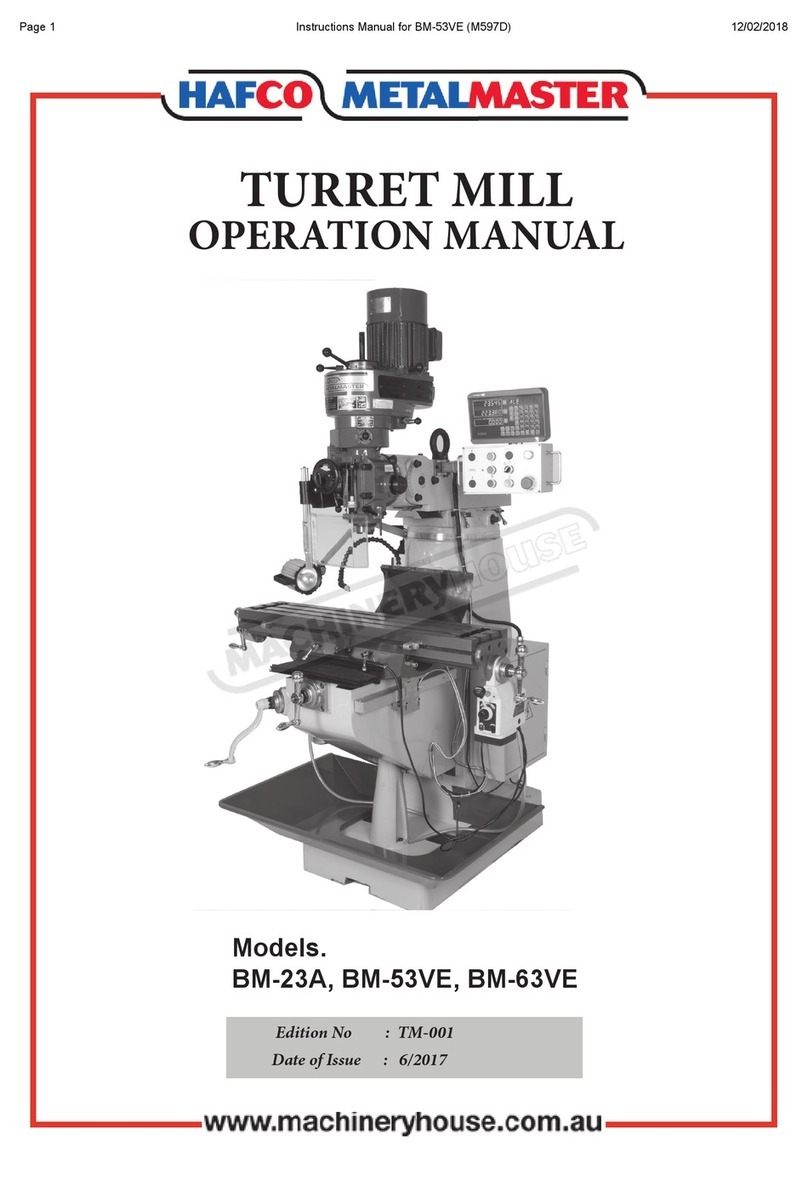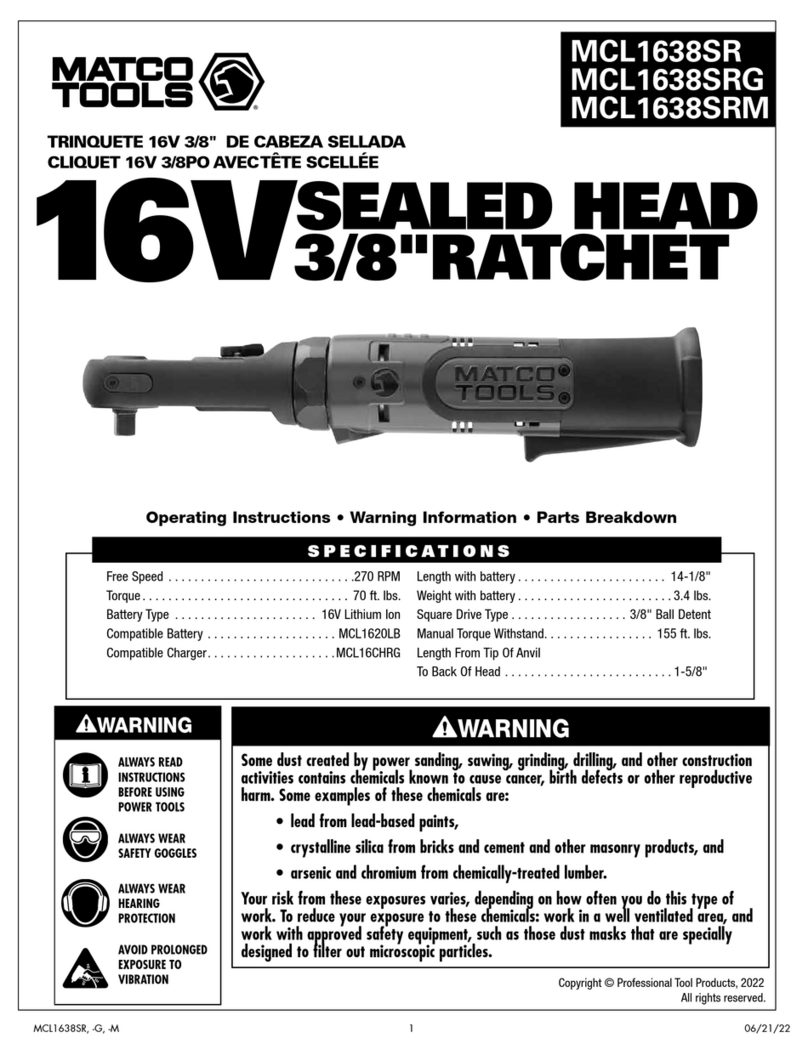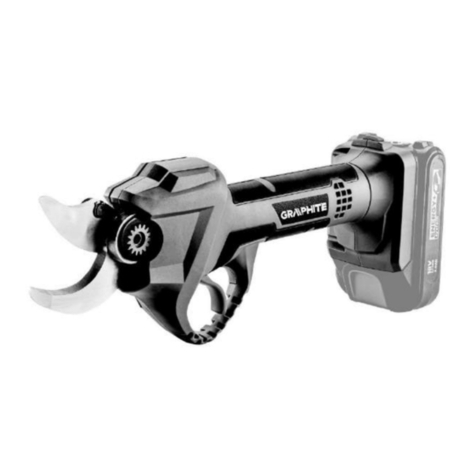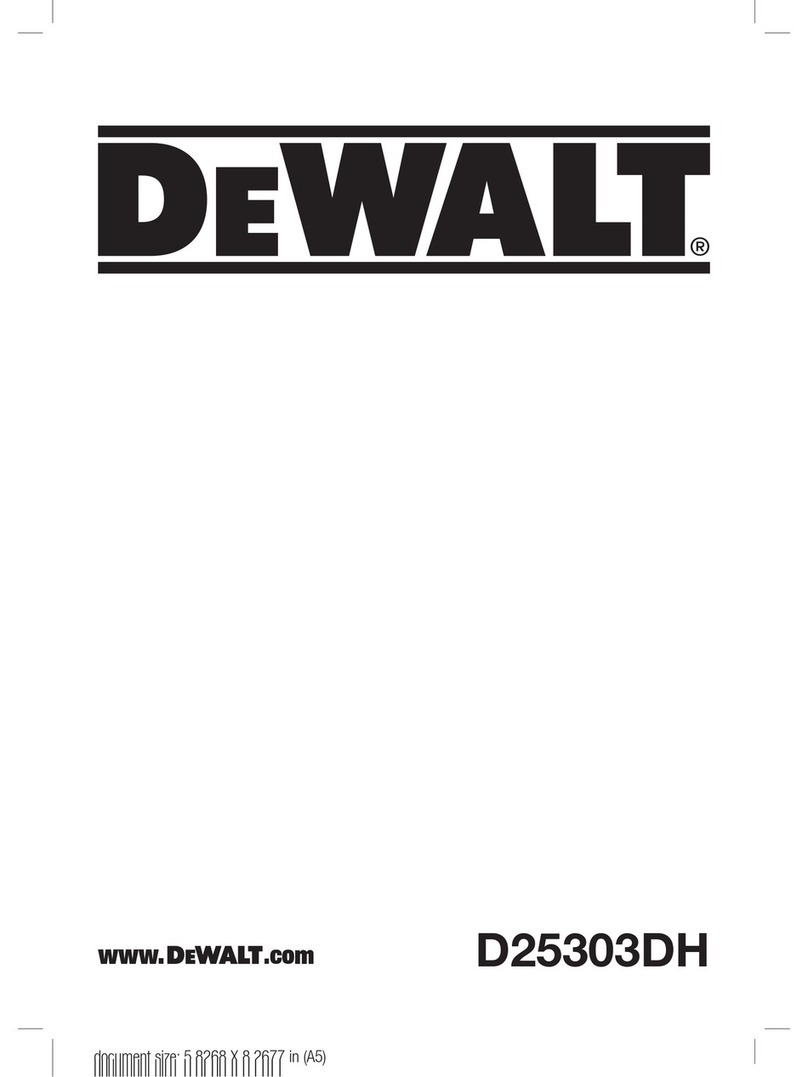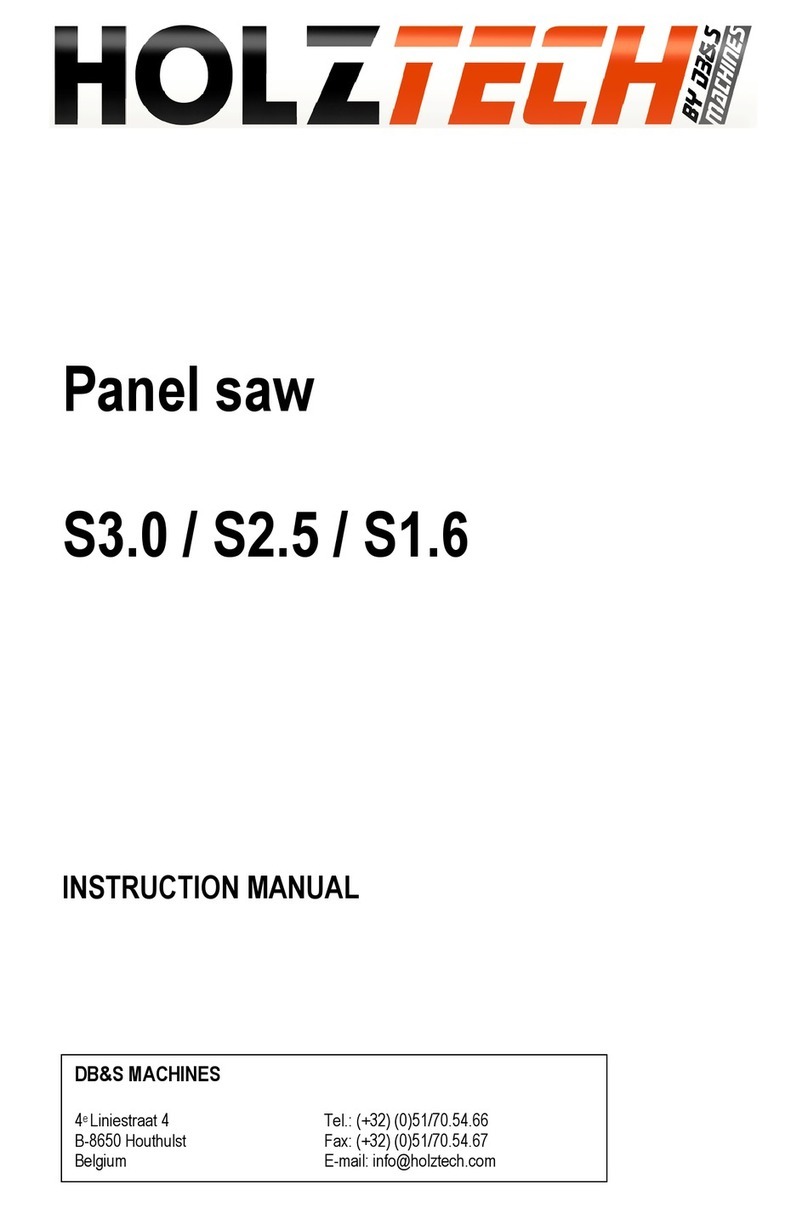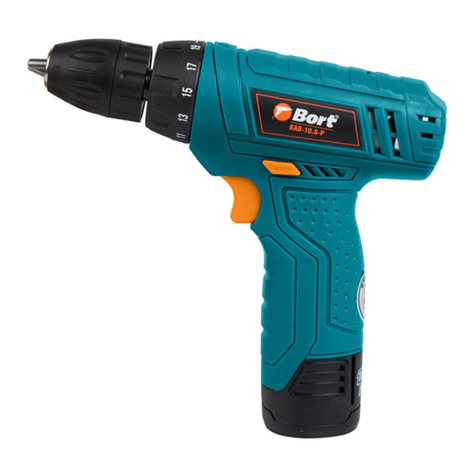MachineryHouse Hafco MetalMaster HM-51B User manual

TURRET MILLING MACHINE
OPERATION MANUAL
Edition No :TM-5154-1
Date of Issue :10/2019
Models.
HM-51B, HM-54GB
Prodcut Code M577, Product Code. M579
HM-51B
HM-54GB
08/11/2019
Instructions Manual for HM-54GV (M579)
1

2
OPERATION MANUAL
NOTE:
In order to see the type and model of the machine, please see the
specication plate. Usually found on the back of the machine. See
example (Fig.1)
Fig.1
TURRET MILLING MACHINE
MACHINE
MODEL NO.
SERIAL NO.
DATE OF MANF.
NOTE:
This manual is only for your reference. Owing to the continuous improvement of the HAFCO
machines, changes may be made at any time without obligation or notice. Please ensure
the local voltage is the same as listed on the specication plate before operating this
electric machine.
Distributed by
www.machineryhouse.co.nz
MACHINE DETAILS
08/11/2019
Instructions Manual for HM-54GV (M579)
2

3
OPERATION MANUAL
C O N T E N T S:
1. GENERAL MACHINE INFORMATION
1.1 Specications................................................................ 4
1.2 Identication HM-51B............................................... 5
1.3 Identication HM-54GB............................................ 6
2. IMPORTANT INFORMATION
2.1 General Metalworking Safe Practices.................. 7
2.2 Safe Work Practices For Milling Machine............ 10
2.3 Lifting Instructions..................................................... 11
3. SETUP
3.1 Clean Up......................................................................... 12
3.2 Site Preparation........................................................... 12
3.3 Machine Leveling........................................................ 13
3.4 Electrical Installation.................................................. 13
3.5 Full Load Current Rating........................................... 14
4. COMMISSIONING
4.1 Basic Controls............................................................... 14
4.2 Power Feed.................................................................... 17
4.3 Test Run.......................................................................... 18
5. OPERATION
5.1 Table Movements........................................................ 20
5.2 Head Movements........................................................ 21
5.3 Mounting The Tooling............................................... 23
5.4 Horizontal Setup (HM-54GV).................................. 24
5.5 Changing The Spindle Speeds............................... 24
6. MAINTENANCE
6.1 Lubrication Schedule................................................. 28
6.2 Gib Adjustment............................................................ 29
6.3 Troubleshooting.......................................................... 30
SPARE PARTS.......................................................................... 32
Risk Assessment................................................................... 51
08/11/2019
Instructions Manual for HM-54GV (M579)
3

4
OPERATION MANUAL
1.1 SPECIFICATIONS
Product Code M577 M579
Model HM-51B HM-54GV
Type Vertical Vertical/Horizontal
Table Size (mm) 1000 x 240 1000 x 240
Spindle Taper Horizontal Nil NT-30
Spindle Taper Vertical NT-30 NT-30
Longitudinal Travel (X-Axis) (mm) 580 600
Cross Travel (Y-Axis) (mm) 190 200
Vertical Travel (Z-Axis) (mm) 350 340
Type of Slides Dovetail Dovetail
Ram Travel (mm) 350 450
Spindle to Table (mm) 390 375
Spindle Travel / Diameter (mm) 125/90 125/90
Throat Depth (max.) (mm) 550 640
Tilting Head (Left ~ Right) ±90 ° ±45 °
Tilting Head (Forward ~ Back) Fixed Fixed
Drilling Capacity (mm) 30 40
End Milling Capacity (mm) 25 25
Face Milling Capacity (mm) 80 80
Power Feed - Quill (mm/rev) Manual Manual
Power Feed - Longitudinal (X-Axis) (mm/min) 20 - 2000 20 - 2000
Power Feed - Cross (Y-Axis) (mm/min) Optional Optional
Power Feed - Vertical (Z-Axis) (mm/min) Optional Optional
Table T-Slot Size (mm) 14 14
Work Table Load Capacity (kg) 175 160
Work Table Swivel (LH/RH) 30 °/40 ° 30 °/40 °
Spindle Speeds Vertical (no/rpm) 9 (220 - 2400) Variable (100 - 2000)
Spindle Speeds Horizontal (no/rpm) Nil 9 (60 - 1350)
Motor Power - Vertical (kW/hp) 2.2 / 3 2.2 / 3
Motor Power - Horizonta (kW/hp) Nil 1.5 / 2
Voltage / Amperage (V/amp) 240/15 240/15
Dimensions (L x W x H) (mm) 138 x 140 x 210 138 x 150 x 215
Shipping Dimensions (L x W x H) (mm) 134 x 114 x 227 134 x 114 x 225
Weight (kg) 850 900
08/11/2019
Instructions Manual for HM-54GV (M579)
4

5
OPERATION MANUAL
1.2 IDENTIFICATION HM-51B
B
AHead IBase
BMotor JsplasH tray
CBelt drive cover Kcoolant puMp
DraM L“Z” axis Handle
Edigital readout M“y” axis Handle
FtaBle Nspindle guard
G“x” axis Hand-wHeel Ospindle Fine Feed Hand-wHeel
Hpower Feed unit Pcontrol panel
a
c
d
e
F
g
H
K
l
J
i
M
n
o
p
08/11/2019
Instructions Manual for HM-54GV (M579)
5

6
OPERATION MANUAL
1.3 IDENTIFICATION HM-54GB
B
AHead IBase
BMotor JsplasH tray
CvariaBle speed selector Kcoolant puMp
DHoriZontal arBor support L“Z” axis Handle
Edigital readout M“y” axis Handle
FtaBle Nspindle guard
G“x” axis Hand-wHeel Ospindle Fine Feed Hand-wHeel
Hpower Feed unit P2 xcontrol panels
ac
de
F
g
H
K
l
J
i
M
n
o
p
p
08/11/2019
Instructions Manual for HM-54GV (M579)
6

7
OPERATION MANUAL
DO NOT use this machine unless you have read this manual or have been instructed in the use
of this machine in its safe use and operation
This manual provides safety instructions on the proper setup, operation, maintenance, and
service of this machine. Save this manual, refer to it often, and use it to instruct other operators.
Failure to read, understand and follow the instructions in this manual may result in re or
serious personal injury—including amputation, electrocution, or death.
The owner of this machine is solely responsible for its safe use. This responsibility includes, but
is not limited to proper installation in a safe environment, personnel training and authorization
to use, proper inspection and maintenance, manual availability and comprehension, of the
application of the safety devices, integrity, and the use of personal protective equipment.
The manufacturer will not be held liable for injury or property damage from negligence,
improper training, machine modications or misuse.
WARNING
2.1 GENERAL METALWORKING SAFE PRACTICES
Always wear safety glasses or goggles.
Wear appropriate safety footwear.
Wear respiratory protection where required.
Gloves should never be worn while operating the machine, and only worn when
handling the workpiece.
Wear hearing protection in areas > 85 dBA. If you have trouble hearing someone speak
from one metre (three feet) away, the noise level from the machine may be hazardous.
DISSCONNECT THE MACHINE FROM POWER when making adjustments or servicing.
Check and adjust all safety devices before each job.
Ensure that guards are in position and in good working condition before operating.
Ensure that all stationary equipment is anchored securely to the oor.
Ensure all machines have a start/stop button within easy reach of the operator.
Each machine should have only one operator at a time. However, everyone should know
how to stop the machine in an emergency.
08/11/2019
Instructions Manual for HM-54GV (M579)
7

8
OPERATION MANUAL
Ensure that keys and adjusting wrenches have been removed from the machine before
turning on the power. Appropriate storage for tooling should be provided.
Ensure that all cutting tools and blades are clean and sharp. They should be able to cut
freely without being forced.
Stop the machine before measuring, cleaning or making any adjustments.
Wait until the machine has stopped to clear cuttings with a vacuum, brush or rake.
Keep hands away from the cutting head and all moving parts.
Avoid awkward operations and hand positions. A sudden slip could cause the hand to
move into the cutting tool or blade.
Return all portable tooling to their proper storage place after use.
Clean all tools after use.
Keep work area clean. Floors should be level and have a non-slip surface.
Use good lighting so that the work piece, cutting blades, and machine controls can be seen
clearly. Position or shade lighting sources so that they do not cause any glare or reections.
Ensure there is enough room around the machine to do the job safely.
Obtain rst aid immediately for all injuries.
Understand that the health and re hazards can vary from material to material. Make sure all
appropriate precautions are taken.
Clean machines and the surrounding area when the operation is nished.
Use proper lock out procedures when servicing or cleaning the machines or power tools.
Do not distract an operator. Horseplay can lead to injuries and should be strictly
prohibited.
Do not wear loose clothing, gloves, necktie’s, rings, bracelets or other jewellery that can
become entangled in moving parts. Conne long hair.
Do not handle cuttings by hand because they are very sharp. Do not free a stalled cutter
without turning the power o rst. Do not clean hands with cutting uids.
Do not use rags near moving parts of machines.
Do not use compressed air to blow debris from machines or to clean dirt from clothes.
DO NOT
×Do not distract an operator. Horseplay can lead to injuries and should be strictly
prohibited.
×Do not wear loose clothing, gloves, necktie’s, rings, bracelets or other jewellery that can
become entangled in moving parts. Conne long hair.
×Do not handle cuttings by hand because they are very sharp. Do not free a stalled cutter
without turning the power o rst. Do not clean hands with cutting uids.
×Do not use rags or wear gloves near moving parts of machines.
×Do not use compressed air to blow debris from machines or to clean dirt from clothes.
×Do not force the machine. It will do the job safer and better at the rate for which it was
designed.
2.1 GENERAL METALWORKING SAFE PRACTICES Cont.
08/11/2019
Instructions Manual for HM-54GV (M579)
8

9
OPERATION MANUAL
2.1 GENERAL METALWORKING SAFE PRACTICES Cont.
HAZARDS ASSOCIATED WITH MACHINES include, but are not limited to:
• Being struck by ejected parts of the machinery
• Being struck by material ejected from the machinery
• Contact or entanglement with the machinery
• Contact or entanglement with any material in motion
Health Hazards (other than physical injury caused by moving parts)
• Chemicals hazards that can irritate, burn, or pass through the skin
• Airborne items that can be inhaled, such as oil mist, metal fumes, solvents, and dust
• Heat, noise, and vibration
• Ionizing or non-ionizing radiation (X-ray, lasers, etc.)
• Biological contamination and waste
• Soft tissue injuries (for example, to the hands, arms, shoulders, back, or neck) result
ing from repetitive motion, awkward posture, extended lifting, and pressure grip)
Other Hazards
• Slips and falls from and around machinery during maintenance
• Unstable equipment that is not secured against falling over
• Safe access to/from machines (access, egress)
• Fire or explosion
• Pressure injection injuries from the release of uids and gases under high pressure
• Electrical Hazards, such as electrocution from faulty or ungrounded electrical
components
• Environment in which the machine is used (in a machine shop, or in a work site)
Machines are safeguarded to protect the operator from injury or death with the placement of
guards. Machines must not be operated with the guards removed or damaged.
08/11/2019
Instructions Manual for HM-54GV (M579)
9

10
OPERATION MANUAL
2.2 SAFE WORK PRACTICES FOR MILLING MACHINE
DO NOT use this machine unless you have been instructed in its safe use and operation
and have read and understand this manual
Safety glasses must
be worn at all times
in work areas.
Long and loose hair
must be contained.
Gloves must not be
worn when using this
machine
Sturdy footwear
must be worn at all
times in work areas
Close tting/protec-
tive clothing must be
worn.
Rings and jewellery
must not be worn.
PRE-OPERATIONAL SAFETY CHECKS
qLocate and ensure you are familiar with all machine operations and controls.
qEnsure all guards are tted, secure and functional. Do not operate if guards are
missing or faulty.
qCheck workspaces and walkways to ensure no slip/trip hazards are present.
qEnsure cutter is in good condition and securely mounted.
qCheck coolant delivery system to allow for sucient ow of coolant.
OPERATIONAL SAFETY CHECKS
qKeep clear of moving machine parts.
qFollow correct clamping procedures. Keep overhangs as small as possible and check
the workpiece is secure.
qSet the correct speed to suit the material, cutter diameter, the depth of cut
ENDING OPERATIONS AND CLEANING UP
qSwitch o the machine when work completed.
qRemove milling cutters and store them safely.
qBefore making adjustments and measurements or cleaning swarf accumulations,
Switch o and bring the machine to a complete standstill.
qLeave the machine and work area in a safe, clean and tidy state.
POTENTIAL HAZARDS AND INJURIES
qSharp cutters. q Hair/clothing caught in moving parts. qEye injuries.
qSkin irritation. qMetal splinters and burrs. qFlying debris.
DON’T
qDo not use faulty equipment. Immediately report suspect machinery.
qNever leave the machine running unattended.
qDo not leave equipment on top of the machine.
08/11/2019
Instructions Manual for HM-54GV (M579)
10

11
OPERATION MANUAL
2.3 LIFTING INSTRUCTIONS
On the day that the machine arrives, make sure that a crane with sucient capacity is available
to unload the machine from the vehicle. Ensure access to the chosen site is clear and that doors
and ceilings are suciently high and wide enough to receive the machine.
To handle the machine, the straps should be positioned so the machine is level when lifted.
When using straps please take note of the strap angle and the loads that apply
When the straps are at a 45° angle then each strap is
carrying the equivalent of 50% of load weight. (Fig.2.1).
When the straps are at a 90° angle then each strap will
have a weight equal to 75% of the load on each strap.
(Fig 2.2)
Note! The manufacturer recommends not to exceed 90°
angle
Fig 2.2
Fig 2.1.
When lifting the machine only certied lifting straps
should be used.
Ensure that when lifting, the machine does not tip over.
Check that the lifting straps do not interfere with the
hydraulic pipes or electrical conduits.
Failure to follow these instructions could cause damage
to the machine.
To lift the machine
1. Rotate ram 180° clockwise so the headstock faces
backwards
2. Tighten the four turret lock bolts (two on each side
of ram, as shown in Fig.2.3). This will help keep the
ram from unexpectedly moving from the force of
the lifting straps.
Note: Place protective material between the straps and
mill to protect the ram and ways, and to prevent cutting
the lifting straps.
3. Place lifting straps under ram and connect to a
safety hook, (Fig. 2.4)
4. With other people steadying load to keep it from
swaying, lift machine a couple of centimeters.
— If mill tips to one side, lower it to the pallet
and adjust ram or table to balance load.
Make sure to re-tighten lock levers and bolts
before lifting mill again.
LIFTING POINTS
Fig. 2.4
Fig. 2.3
08/11/2019
Instructions Manual for HM-54GV (M579)
11

12
OPERATION MANUAL
The unpainted surfaces of the machine have been coated with a waxy oil to protect them from
corrosion during shipment. Remove the protective coating with a solvent cleaner or a citrus
based degreaser.
Optimum performance from your machine will be achieved when you clean all moving parts or
sliding contact surfaces that are coated with rust prevented products.
It is advised to avoid chlorine based solvents, such as acetone or brake parts cleaner, as they
will damage painted surfaces and strip metal should they come in contact. Always follow the
manufacturer’s instructions when using any type of cleaning product.
3.1 CLEAN UP
3. SETUP
OPTIONS FOR MOUNTING
The machine is best mounted on a concrete slab.
Masonry anchors with bolts are the best way to anchor ma-
chinery, because the anchors sit ush with the oor surface,
making it easy to unbolt and move the machine later, if
needed. (Fig. 3.1)
3.2 SITE PREPARATION
When selecting the site for the machine, consider the largest size of workpiece that will be
processed through the machine and provide enough space around the machine for operat-
ing the machine safely. Consideration should be given to the installation of auxiliary equip-
ment. Leave enough space around the machine to open or remove doors/covers as required
for the maintenance and service as described in this manual.
It is recommended that the machine is anchored to the oor to prevent tipping or shifting. It
also reduces vibration that may occur during operation.
In some case a suitable foundation may not be available
and a new one may need to be prepared.
The foundation should be concrete approximately 300mm
thick with pockets left clear for the hold down bolts.. The
hold down bolts can be “L” shape as per the example in
Fig. 3.2
Fig. 3.2
Fig. 3.1
08/11/2019
Instructions Manual for HM-54GV (M579)
12

13
OPERATION MANUAL
3.3 MACHINE LEVELING
To set your machine up so that it operates to optimum performance, apply the following
procedure
After your machine has been anchored to a concrete slab oor, it then needs to be leveled.
Loosen the hold down bolts and place a level on the surface of the working table. Metal shims
need to be placed under the corners of the base of the machine until level. Once level then
tighten the hold down bolts. (Fig. 3.1).
The machine must not rest on supports
other than those dened in Fig. 3.2 & Fig.3.3
Metal sHiM
Hold down Bolt
Fig. 3.3
Place the machine near an existing power source. Make sure all power cords are protected from
trac, material handling, moisture, chemicals, or other hazards. Make sure there is access to a
means of disconnecting the power source. The electrical circuit must meet the requirements for
240V. To minimize the risk of electrocution, re, or equipment damage, these machines should
be plugged directly into the socket, or hard wired with the installation work and electrical wir-
ing done by a qualied electrician.
NOTE : The use of an extension cord is not recommended as it may decrease the life of electrical
components on your machine.
3.4 ELECTRICAL INSTALLATION
ELECTRICAL REQUIREMENTS
Nominal Voltage.........................................240V
Cycle...............................................................50 Hz
Phase...............................................Single Phase
Power Supply Circuit.........................15 Amps
Full Load Current.............................13.6 Amps
(Full load current rating is also on the specication plate on the motor.)
08/11/2019
Instructions Manual for HM-54GV (M579)
13

14
OPERATION MANUAL
The full-load current rating is the amperage a machine draws when running at 100% of the out-
put power. Where machines have more than one motor, the full load current is the
amperage drawn by the largest motor or a total of all the motors and electrical devices that
might operate at one time during normal operations.
Full-Load Current Rating for these machine at 240V is 13.6 Amps
It should be noted that the full-load current is not the maximum amount of amps that the
machine will draw. If the machine is overloaded, it will draw additional amps beyond the
full-load rating and if the machine is overloaded for a long period of time, damage, overheating,
or re may be caused to the motor and circuitry.
This is especially true if connected to an undersized circuit or a long extension lead. To reduce
the risk of these hazards, avoid overloading the machine during operation and make
sure it is connected to a power supply circuit that meets the requirements.
3.5 FULLLOAD CURRENT RATING
4. COMMISSIONING
4.1 BASIC CONTROLS
The following descriptions are supplied to give the help the operator develop an understanding
of the basic controls used to operate the milling machine. This knowledge will be necessary to
safely complete the Test Run later in this manual.
Fig. 4.1
Isolating Power Switch: The switch is found on the
electrical control box mounted on the side of the
machine. The switch enables power to ow to the
machine when the “ON”is visible at the top of the
switch.
08/11/2019
Instructions Manual for HM-54GV (M579)
14

15
OPERATION MANUAL
4.1 BASIC CONTROLS CONT.
A. Power Lamp Button: When it is illuminated it
enables power to the control panel. The Emer
gency STOP buttons must be reset rst.
B. Forward Button: Starts the horizontal spindle
in a forward rotation (clockwise when facing the
spindle).
C. Reverse Button: Starts the horizontal spindle in
a reverse rotation (counterclockwise when
facing the spindle).
D. STOP Button: Stops the spindle rotation.
E. Emergency STOP Button: Disables power to
the control panel and stops all machine
functions. To reset, twist the button clockwise
until it pops out.
A. Power Lamp Button: When pressed, illuminates
and enables power to both control panels. Both
Emergency STOP buttons must be reset rst.
B. Forward Button (Vertical Spindle): Starts
vertical spindle forward rotation (clockwise
looking down on the headstock).
C. Reverse Button (Vertical Spindle ): Starts
vertical spindle reverse rotation (counterclock
wise looking down on the headstock).
D. STOP Button (Vertical Spindle ): Stops
vertical spindle rotation.
E. Coolant Switch: Turns ON or OFF the coolant
pump
F. Emergency STOP Button: Disables power to
both control panels and stops all machine
functions. To reset, twist the button clockwise
until it pops out.
FORWARD REVERSE
STOP
a
c
d
e
HM-54GV
G. Rotary Speed Control Knob and Display: Controls the speed of the vertical spindle and
displays the RPM on the display.
H. Forward Button (Horizontal Spindle): Starts the horizontal spindle in a forward rotation
(clockwise when facing the spindle).
I. Reverse Button (Horizontal Spindle): Starts horizontal spindle in a reverse rotation
(anti-clockwise when facing the spindle).
J. STOP Button (Horizontal Spindle): Stops the horizontal spindle rotation
B
CONTROLS ON THE KNEE
B
c
d
e
F
g
H
i
J
a
g
Fig. 4.2
Fig.4.3
08/11/2019
Instructions Manual for HM-54GV (M579)
15

16
OPERATION MANUAL
HM-51B
A. Power Lamp Button: When pressed, illuminates
and enables power to the control panel. The
Emergency Stop buttons must be reset rst.
B. Forward Button: Starts the spindle in a forward
rotation (clockwise looking down on the head).
C. Reverse Button: Starts the spindle reverse
rotation (counterclockwise looking down on the
head).
D. Stop Button: Stops the spindle rotation.
E. Coolant Switch: Turns ON or OFF the coolant
pump
F. Emergency Stop Button: Disables power to
the control panel and stops all machine
functions. To reset, twist the button clockwise
until it pops out.
4.1 BASIC CONTROLS CONT.
Hi/Low Speed Selector: Selects the speed range
for either HIGH or LOW.
NOTE: The lever must only be changed when the
spindle is stopped.
HM-54GV
Fig.4.4
a
B
c
d
e
F
Fig.4.5
08/11/2019
Instructions Manual for HM-54GV (M579)
16

17
OPERATION MANUAL
4.2 POWER FEED UNIT
A. Directional Lever: Selects the direction of table
movement. The center position is neutral.
B. Rapid Traverse Button: Once the directional
lever has been activated, causes the table to
travel at full speed while pushed.
C. Speed Dial: Controls the speed of table move
ment. Turning the dial clockwise causes the table
to move faster.
Note: Feed rates for table travel are extremely
dicult to precisely calculate. We recommend
that you combine research and experimentation
to nd the feed rates that best work for your
operations.
D. ON/OFF Switch: Enables/disables power to the
unit.
E. Reset Button: Resets the internal circuit breaker if
the unit is overloaded and shuts down..
Fig.4.6
A
B
C
ED
F. Limit Switch: Stops powered table movement
when either of the side plungers come in
contact with the limit stops.
G. Limit Stop: Limits X-axis table travel (one on
either end of the table).
H. Graduated Dial: Displays X-axis table movement
in 0.02mm increments, with each revolution
equaling 4mm of travel.
I. Handwheel: Manually positions the table.
J. Table Locks: Locks the table when in position.
FGIH
J
The table stops MUST be loosened before the
table feed is used. Failure to do so may cause damage to the gears in the powerfeed unit.
Fig.4.7
08/11/2019
Instructions Manual for HM-54GV (M579)
17

18
OPERATION MANUAL
Once assembly is complete, the machine needs a test run to ensure it is connected properly to
power and functions correctly. During the test run, checks need to be made to the the proper
operation of the spindle, motors, the Emergency Stop buttons, and the power feed unit.
If any unusual problem is found during the test run, immediately stop the machine, disconnect
it from the power supply, and x the problem before operating the machine again. For possible
answers, refer to the The Troubleshooting table in the Maintenance section of this manual for
help.
4.3 TEST RUN
How To Test Run
1. Read and follow the safety instructions at the beginning of the manual, take required safety
precautions, and make sure the machine is set up and adjusted correctly.
2. Clear away all tools and objects used during assembly and preparation.
3. Make sure mill is properly lubricated (refer to Lubrication section beginning on Page 28 for
specic details).
4. (HM-51B) Position vertical spindle V-belts for 220 RPM. Refer to Changing The Spindle
Speed, beginning on Page 25 for detailed instructions).
(HM-54GV). Adjust the variable spindle speed to 220rpm and horizontal spindle V-belts for
72 RPM (See details on page 26)
5. Push the Emergency Stop buttons to avoid unexpected
start up when machine is connected to power.
6. Connect mill to power source specied on Page 13
7. Turn power isolation switch ON.
8. Twist the Emergency Stop buttons clockwise until they
pop out—this resets them for operation (see Fig.4.8).
9. Press Power Lamp button on master control panel to
enable power to the control panels—the button should
illuminate.
10. Start vertical spindle forward rotation.
11. Listen for abnormal noises and watch for anything unex
pected from the mill. The mill should run smoothly and
without excessive vibration or rubbing noises. Strange or
unusual noises or actions must be investigated
immediately. Turn the machine OFF and disconnect it
from the power source before investigating or correcting
potential problems.
Fig.4.8
12. Stop spindle rotation and wait for spindle to completely stop.
13. Repeat Steps 11–12 with vertical spindle reverse rotation.
14. (HM-54GV Only) Repeat Steps 10–12 with horizontal spindle.
15. Press Emergency Stop button on master control panel.
16. Without resetting the Emergency Stop button, attempt to start vertical spindle rotation.
The machine should not start. If the machine does start (with the Emergency Stop button
pushed in), immediately disconnect power to the machine. The Emergency Stop button
safety feature is not working correctly. This safety feature must work properly before
proceeding with regular operations. Call your local distributor for help.
17. Reset Emergency Stop button.
18. (HM-54GV Only) Repeat Steps 15–17 with horizontal spindle control sub-panel and
horizontal spindle
08/11/2019
Instructions Manual for HM-54GV (M579)
18

19
OPERATION MANUAL
Power Feed Test Run:
The mill comes with a power feed unit for X-axis table travel. Proper operation of the limit
switch attached in the middle of the table at the front, is critical for the safe use of this power
feed unit. If the power feed does not operate as expected during the following steps, discon-
nect it from power and contact your local distributer
To test the power feed:
1. Make sure all tools, cables, and other items are well clear of table movement as you follow
these steps.
2. Refer to Power Feed identication on Page 17, to understand how power feed, table locks,
and limit switch function.
3. Move the limit stops so they are within 100mm of the limit switch and tighten.
4. Loosen table locks on the front of table. Make sure power feed directional lever is in neutral
(middle) position, turn speed dial counterclockwise to lowest setting, then turn power feed
ON.
5. Move direction knob to the left, slowly rotate speed dial clockwise to increase speed, then
conrm table is moving left.
6. Watch for table limit stop to hit the limit switch which will turn the power feed OFF,
stopping table movement.
7. Move direction knob through the neutral (middle) position and all the way right. Table
should begin moving right.
8. Conrm the table stops moving when limit stop presses against limit switch plunger.
9. Move direction knob to the neutral (middle) position, turn speed dial counterclockwise to
lowest setting, and turn power feed OFF
5. OPERATION
The purpose of this overview is to provide the novice machine operator with a basic under-
standing of how the machine is used during operation, so the machine controls/components
discussed later in this manual are easier to understand.
Due to the generic nature of this overview, it is not intended to be an instructional guide. To
learn more about specic operations, read this entire manual and seek additional training from
experienced machine operators, and do additional research outside of this manual by reading
“how-to” books, trade magazines, or visiting instructional websites.
To complete a typical operation, the operator should do the following
1. Examines the workpiece to make sure it is suitable for the operation.
2. Firmly clamp the workpiece to the table or hold the workpiece in a mill vise.
3. Install the correct cutting tool for the operation.
4. Use the downfeed and table controls to correctly position the cutting tool and workpiece
for the operation. If the X-axis power feed is to be used during the operation, the operator
must conrm the speed and length of the table movement required.
5. Congure the machine for the correct spindle speed, and if coolant is to be used for the
operation.
6. The operator must put on personal protective gear, and make sure the workpiece and table
are clear of all tools, cords, and other items.
7. Start the spindle rotation and perform the operation.
8. Turn the machine OFF.
4.3 SETUP CONT.
08/11/2019
Instructions Manual for HM-54GV (M579)
19

20
OPERATION MANUAL
5.1 TABLE MOVEMENTS
The mill table travels in three directions, as illustrated
in Fig. 5.1
These movements are controlled by table handwheels
and the Z-axis crank. Additionally, the table can be
moved along the X-axis with the power feed and
rotated 45° left and right.
GRADUATED INDEX RINGS
The table handwheels and knee crank have
graduated rings (see Fig. 5.2) that are used to
determine table movement in 0.02mm increments.
Additionally, each dial has a thumbscrew that is
used to adjust the dial to zero.
Fig. 5.2
“x” longitudinal travel
“y” cross travel
“Z” vertical travel
TABLE LOCKS
Use table locks to increase the rigidity of the table
when movement in that direction is not required
for the operation.
Refer to Fig. 5.3 to identify the locks for each
table axis.
Fig. 5.1
“x” axis locKs
“y” axis locKs
“Z” axis locKs
Fig. 5.3
08/11/2019
Instructions Manual for HM-54GV (M579)
20
This manual suits for next models
1
Table of contents
Other MachineryHouse Power Tools manuals
Popular Power Tools manuals by other brands
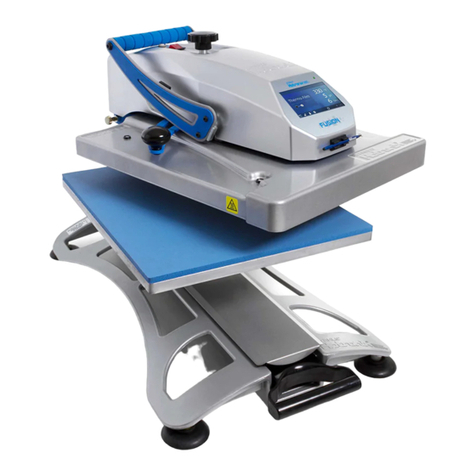
Stahls Hotronix
Stahls Hotronix Fusion XF manual
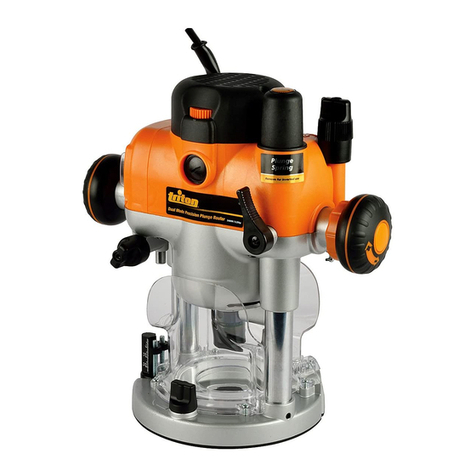
Triton
Triton TRA001 Operating/safety instructions
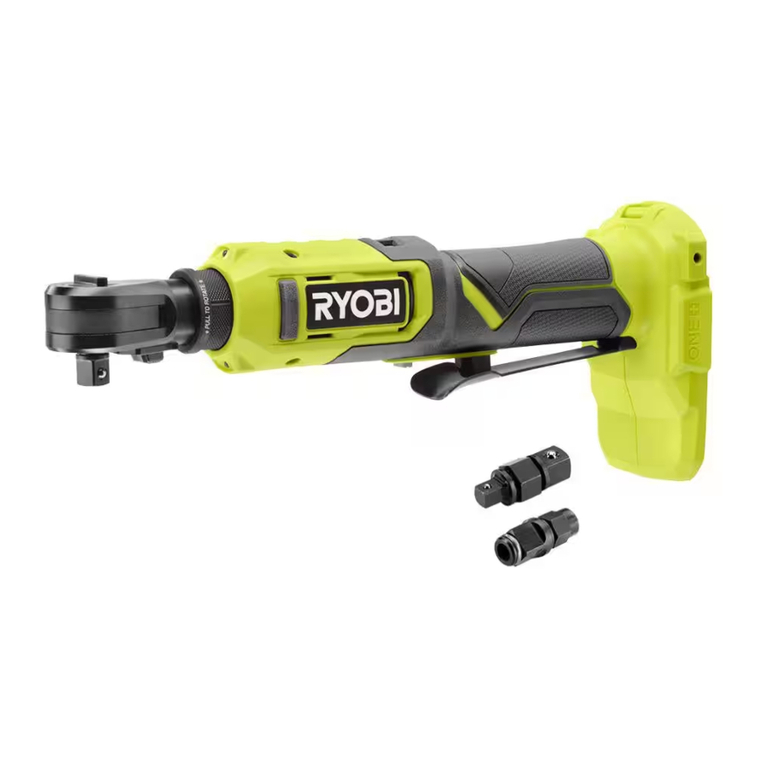
Ryobi
Ryobi PCL28 user manual
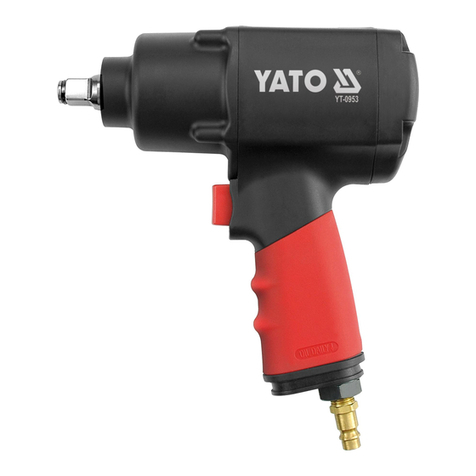
YATO
YATO YT-0953 Original instructions
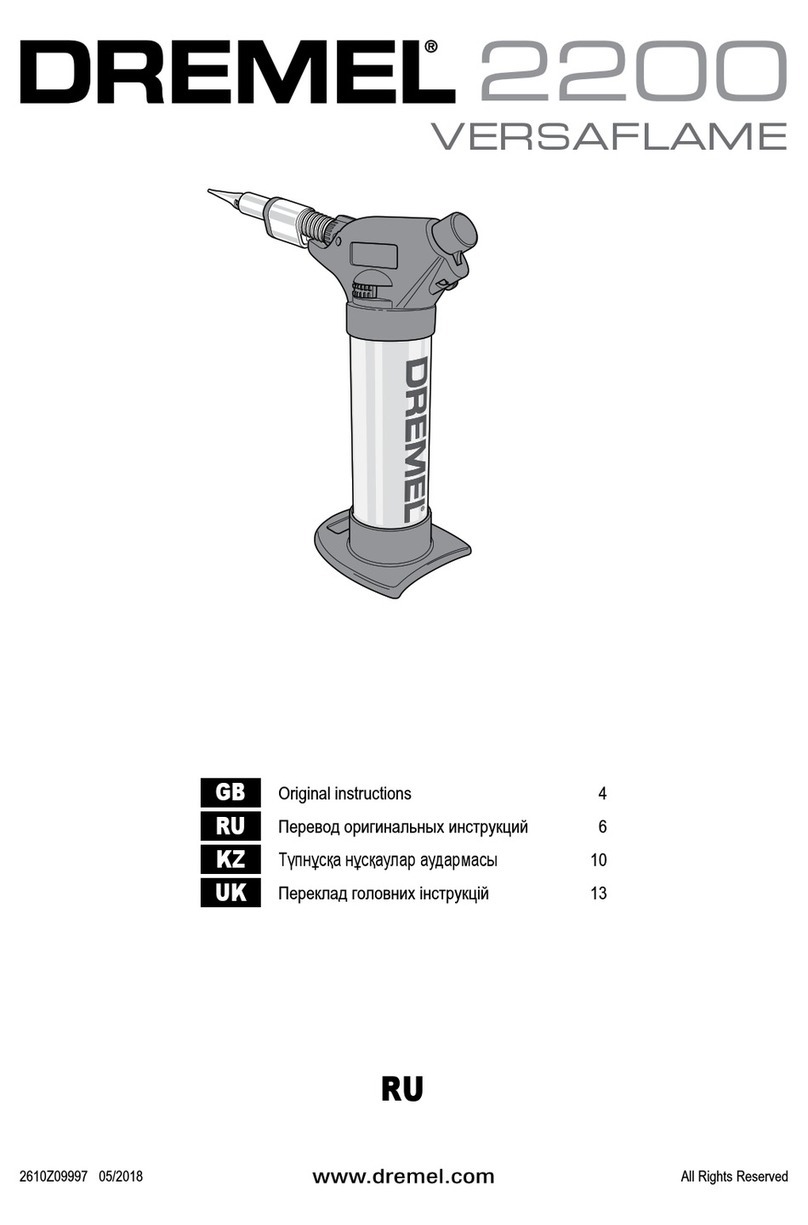
Bosch
Bosch Dremel VERSAFLAME 2200 Original instructions
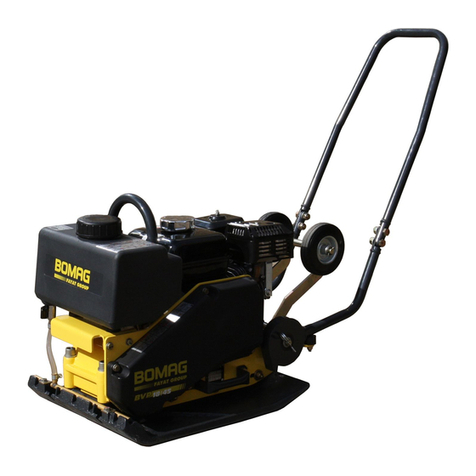
Fayat Group
Fayat Group Bomag BVP 10/36 Operating Instruction, Maintenance Instruction
